Scattered throughout the Earth, there are places that look as terrifying and unsettling as any nightmare. They can be man-made or naturally created, but they also give off a disturbing aura that haunts any who visits or lays eyes on the area. So if you’re looking for a creepy vacation or places you should avoid at all costs, please read on and venture into some of the scariest real life places.
10. Kolmanskop, Namib Desert

Do you ever have a nightmare where you are running, but can’t seem to run fast enough? It’s as if you are running in sand or water. Well, if those dreams terrify you, perhaps you should stay away from the ghost town of Kolmanskop in the Namib Desert in southern Namibia.
In 1908, the town attracted a large amount of people because of the discovery of diamonds in the sand. It was a bustling town, complete with a casino, ballrooms, theaters and a hospital. The town saw a decrease in the population because the price of diamonds dropped drastically during World War II. Also, bigger diamonds were soon found in a different part of the desert and by 1956, people left Kolmanskop leaving it to be consumed by the desert.
Since the air is so dry, the buildings are slowly decaying and then sandstorms have blown sand into the buildings, making it look like the town is drowning in sand.
9. Shicheng, China
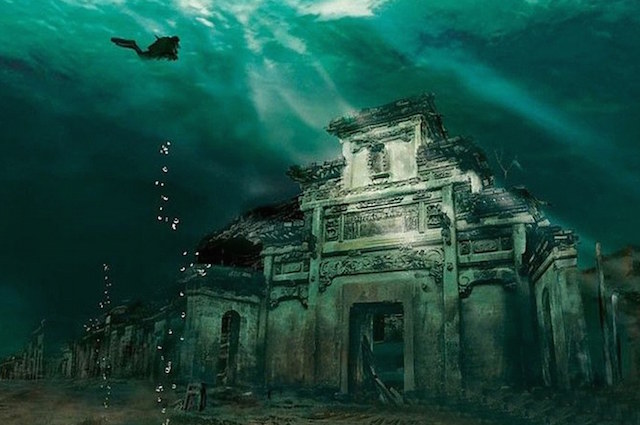
Shicheng is a 600-year-old city in China that was inhabited by 300,000 people until 1959, when it was flooded to make room for the construction of the Xin’an Dam and a hydroelectric plant. The city was flooded and the area was officially called Qiandao Lake. All the buildings, some dating back to the Ming and Qing Dynasties (1368 to 1912), now sit 130 feet underwater.
In 2001, Shicheng was “rediscovered” and earned the nickname “Atlantis of the East.” Much of the architecture remains intact and because it’s submerged, it is safe from the wind, rain and the sun. Experienced scuba divers can explore the walled city and look at stonework of lions, dragons and phoenixes.
8. Miranda Castle, Namur, Belgium

Miranda Castle was built in 1886, near Namur, Belgium, by French Aristocrats who had escaped their death via the guillotine. During the Second World War, it was taken over and used as an orphanage. The castle, also known as the Noisy Castle, was in use all the way up to 1991 when it was abandoned.
After the abandonment, there were several offers to buy the decaying castle, but the owners steadfastly refused to sell; possibly because they were cursed by the ghost of orphaned children. Instead, the castle has progressively gotten worse and is now a place where Scooby Doo and his crew would be too terrified to enter.
7. Derweze, Turkmenistan
Turkmenistan is a country in Central Asia that borders Afghanistan. Within the country, there is a town called Derweze, which is in the Karakum (Black Sands) Desert. And not far from the town is a fiery crater that the locals have dubbed “The Door to Hell.”
The crater is 225 feet wide and 99 feet deep and while it does quite literally look like the entrance to hell, it’s actually a natural gas fire. In 1971, there was some drilling going on in the area and the equipment hit a cavern and fell in. Luckily no one was hurt, but scientists were worried that the gas would be poisonous. So in an incredible miscalculation, scientists suggested starting a fire, thinking it would burn off in a few days. It was afterwards that they found out that Turkmenistan has the fourth largest natural gas reserve in the world and the fire still burns today. The country is hoping to turn the area into a tourist attraction.
6. Capela dos Ossos, Évora, Portugal
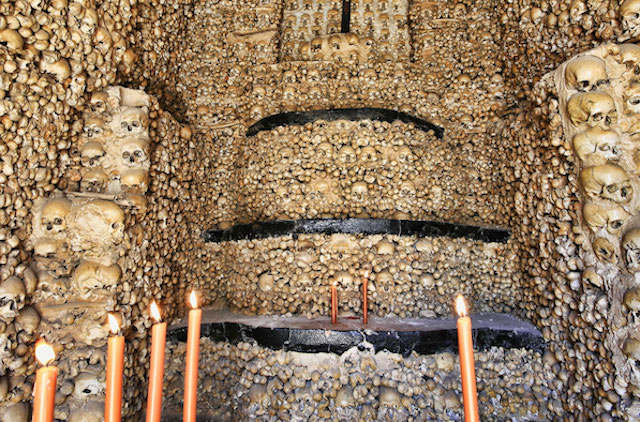
Capela dos Ossos, or “Chapel of Bones” is the most popular tourist attraction in the medieval Portuguese city of Évora. The big draw of the 16th century chapel is a room that was constructed from the bones of 5,000 monks. Then just to make it even creepier, there is also the body of a woman and a child hanging from a wall, but no one is really sure why their bodies are there.
The reason the monks bones’ were used was because at the time it was constructed in the 16th century, Évora was running out of room to bury people. There were already 43 cemeteries and the city was going to get rid of a few. In order to save the souls of monks that died, 5,000 of their bodies were exhumed. With the remains, the church decided to use them as a message to the wealthy citizens of Évora. They constructed the room using the bones to remind people that once you were dead, you couldn’t take your riches with you. Hence the message at the entrance, “We bones that are here, for your bones we wait.”
5. Hashima Island, Japan
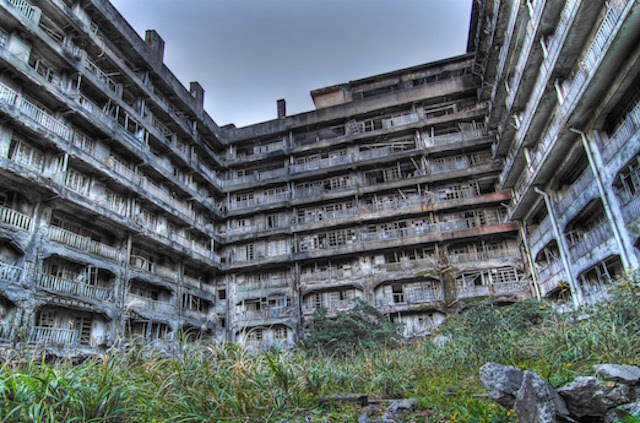
Hashima Island sits about nine miles off the coast of Nagasaki in Southern Japan. In the 1880s, coal was found on the sea floor of the island, and originally, workers were ferried to and from the island. Then the mining company thought it would just be easier to build places for the workers to live. On about 67,000 square feet, which is a little bit larger than a football field, the company created a community complete with restaurants, bathhouses, apartments and even a graveyard. In 1959, 5,259 people were living on the island, making it the most densely populated place on Earth ever.
In 1974, the coal was all mined and the mining company made an announcement that there would be work on the mainland, but it would be on a first come, first serve basis. This caused many people to pick up and leave quickly, leaving behind a lot of personal items like tea cups on tables and bikes leaning up against walls, which gives the island a very post-apocalyptic feel.
Some people may recognize Hashima Island as the headquarters of Raoul Silva, the villain from Skyfall. The island is currently a tourist attraction and there is a boardwalk around it for visitors.
4. Pennhurst State School and Hospital, Pennsylvania

The Eastern Pennsylvania State Institution for the Feeble-Minded and Epileptic opened in 1908 in East Vincent, Pennsylvania. Shortly after opening, the institution was grossly misused. Instead of only taking in people with disabilities, it also housed criminals, immigrants and anyone else who had no place to go, making it overcrowded within months of opening its doors.
By the 1960s, the name had been changed to the Pennhurst State School and Hospital and there were over 2,700 residents, mostly children. The problem was that conditions, like many other state intuitions at the time, were horrible. The staff was minimal and a vast majority of the children were not properly helped. Some doctors were also a bit sadistic. For example, in a news exposé from the mid-1960s, a doctor talked about what he did with one patient he described as “a bully.” The doctor said he discussed with his colleagues, what he could inject into the patient that would cause the most pain but wouldn’t leave permanent damage. After the discussion, he pulled the patient aside and used the substance to chemically torture him.
The exposé brought the conditions of the hospital to light, which signaled the end and by 1987, the school was closed and abandoned. Today it is privately owned and the owners run a haunted house attraction that has drawn criticism because some people feel it’s exploitative.
3. Nara Dreamland, Nara, Japan
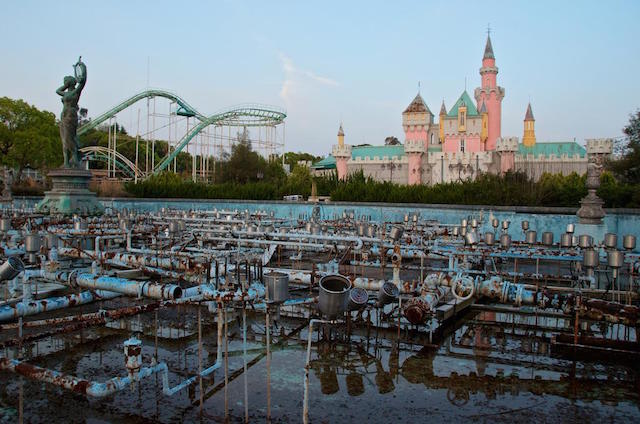
First opened in 1961, near Nara, Japan, Nara Dreamland was a bit of a Disneyland rip-off. It had a lot of the similar fairy tale characters like Sleeping Beauty and Snow White and the park was colorfully painted. But as time progressed, the park’s popularity dwindled and in 2006, they officially closed their doors.
When it closed, much of the park was left intact and it is slowly being reclaimed by nature. There are rusted roller coasters with foliage growing around it and weather beaten castles with faded pictures of cartoon characters. The desolation of the abandoned park makes it a haunting dystopian nightmare that is scarier than any roller coaster that ever ran at the park.
2. Hoia Baciu Forest, Transylvania, Romania

Close to the city of Cluj Napoca in the region of Transylvania, Romania, is the Hoia Baciu forest. The area, nicknamed the “Bermuda Triangle of Transylvania,” first gained international notoriety in 1968 after a biologist took a picture of a UFO flying over it, but the forest itself is actually much creepier than the supposed UFO sighting. Some of the creepy elements include the fact that a number of the trees are misshapen, making them look similar to a lower case “b” or “d.” Then, there is one part of the forest that is completely devoid of trees and paranormal researchers believe it is the epicenter for the strange activity in the forest. This strangeness includes things like people who go into the forest often get an overwhelming feeling of anxiety. Other people return from the forest with strange rashes, unexplained cuts and burns. There are also people who complain of nausea, vomiting and some people even lost time while in the forest.
The locals are also fearful of the forest because there are cases of people entering it and never leaving again. A notable person is a shepherd, who the forest is named after. He walked into the forest with 200 sheep and none of them were ever seen again. Locals also believe that the spirits of murdered people are trapped in the forest.
So if you’re looking for a nice walk in the woods, you may want to avoid this one in Transylvania.
1. Poveglia Island, Italy
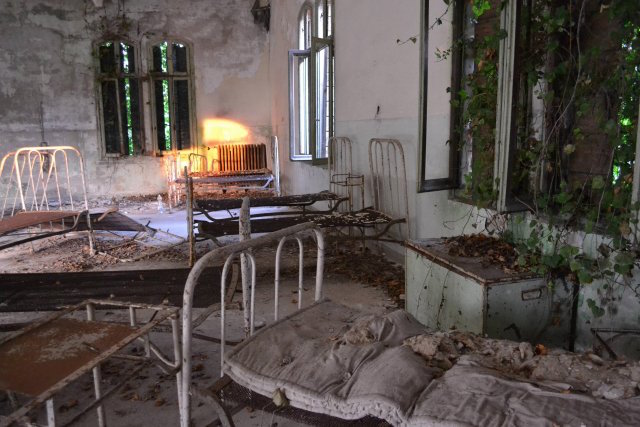
Understandably, people are unsettled by places where a lot of people have lost their lives. If something like that is disturbing to you, we don’t recommend that you make Poveglia Island, Italy as your next vacation designation.
Dubbed “the most haunted island in the world,” Poveglia is in the Venice Lagoon and it has been used on and off since the 9th century. In 1793, the island became a dumping ground for people with the plague. After the people were dead, they were burned and their ashes were scattered throughout the island. Due to the amount of deaths, the soil of Poveglia is 50 percent ash. In addition to the ash, throughout the island there are mass burial sites waiting to be found.
Besides just being a quarantine zone, in 1922, the island became a mental institution and according to the rumors, the doctor who ran it was a sadistic madman, but no record of him could be found. The island was abandoned in 1968 and it fell into decay. It is believed that 10,000 ghosts haunt the islands. In May 2014, the island was sold to a private buyer for about $780,000. It is unclear what the new owners plan to do with the supposedly haunted island.
Robert Grimminck is a Canadian freelance writer. You can friend him on Facebook, follow him on Twitter, follow him on Pinterest or visit his website.